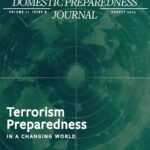In the early morning of New Year’s Day 2025, U.S. citizen Shamsud-Din Jabbar drove a truck into a crowd of people on Bourbon Street in New Orleans, killing 14 people. Like many before him, Jabbar was inspired by the Islamic State terrorist group and posted videos online professing his support before the attack. He wanted to bring focus to the “war between the believers and the disbelievers“ by killing strangers, making the incident the deadliest jihadist attack in the U.S. since the 2016 Pulse nightclub shooting in Orlando, Florida.
Extremism in its various forms is a significant and evolving concern in the U.S. Belief systems and ideas are deemed radical if they are far outside the mainstream and promote violence, hatred, or intolerance. Extremism statistics show a complex landscape with varying trends across different regions and motivations. From January 1, 2023, to May 2025, there were 2,270 terrorism and targeted violence–related incidents in the U.S. alone, impacting over 1,100 cities, injuring over 1,000 people, and killing nearly 500.
The Threat of Extremism
Extremist ideologies promote division between followers and the rest of society, often emphasizing the superiority or righteousness of their own beliefs over those of the mainstream. With no apparent break on the horizon, a continual concern is the ongoing threat of extremism, which may call for or inspire violence with the intention to “intimidate or coerce” society and the government. The 2025 Homeland Threat Assessment report released from the Department of Homeland Security (DHS) calculated that the ongoing threat from both domestic and foreign extremism in the U.S. would remain high throughout 2025. There have been elevated concerns for continued violent extremist responses to domestic sociopolitical events, particularly since the 2024 election cycle and international events like the Iranian nuclear conflict and the ongoing conflict in Gaza, events that could be used to justify or encourage attacks. Aside from the nation-state actors and terrorist organizations, lone offenders and small groups are the principal parties for carrying out violent attacks.
The Role of the Internet
The use of social media and online platforms by extremist and terrorist actors is not necessarily a new phenomenon. Extremism continues to be fueled by the internet, which has generated a hardened disengagement with opposing positions and has proven conducive to promoting violence. The persistent accessibility to and production of extremist content online has increased substantially and is now easily available from “virtually” anywhere. In 2019, El Paso Walmart shooter Patrick Crusius was motivated by the racist and anti-immigrant “Great Replacement” conspiracy theory, which he encountered and engaged with online. He also published a manifesto online before the attack. The 2022 Buffalo Shooting was a racially motivated mass shooting carried out by Payton Gendron who was also motivated by similar racist and antisemitic conspiracy theories and indicated being inspired by online content, including the Christchurch mosque shootings. In November 2022, online hate speech played a significant role in fueling the motivations of Anderson Lee Aldrich who was behind the mass shooting that killed 5 and injured 19 carried out at Club Q, an LGBTQ+ nightclub in Colorado Springs, Colorado. Aldrich is believed to have run a neo-Nazi white supremacist website featuring a shooting training video and other hate-related content. Most recently in 2025, there was an attack at the U.S. Centers for Disease Control and Prevention headquarters, where the shooter believed the COVID vaccine was harmful, reflecting the influence of online misinformation.
Groups like ISIS have extensively used online platforms, including Twitter, Telegram, and other social media, to spread propaganda and recruit members, even prompting the term “cybercaliphate” to describe their online network. In this modern digital age, the radicalization process has been fast-tracked by the internet and the dark web. Social media platforms create echo chambers and amplify extremist narratives, making it easier for individuals to become radicalized. Social media’s unhindered international reach, low entry barriers, and capacity for anonymity make an ideal environment for spreading extremist propaganda, recruiting sympathizers, and exchanging operational knowledge for training.
Online platforms have also increasingly become an important provider of news, with social media playing the most vital role: over half of adults (54%) get news from social media platforms. Social media plays a considerable role in the spread and amplification of extremism, both domestically and internationally. While other platforms also play roles in extremist recruitment, TikTok’s particular design and demographic focus amplify risks for youth, supported by case evidence and expert analysis.
These platforms serve as tools for radicalization, recruitment, and dissemination of extremist ideologies, often disguised within seemingly benign content like news. There is evidence to suggest that the U.S. political situation has radiated instability in society. Domestic sociopolitical events have elevated threats that include racially or ethnically motivated violent extremism, anti-government or anti-authority extremism, and extremist movements motivated by issues like animal rights or abortion.
The Role of Politics
Domestic terrorism in the U.S. is increasingly driven by partisan political views, with a rise in attacks targeting government officials and institutions. From 2016 to 2023, 29% of plots and attacks against government targets started as resistance to U.S. governmental authority, whereas 49% were triggered by partisan political ideologies. These threats manifest in various forms, from attacks on government and law enforcement to violence against individuals and religious institutions. In July 2025, a police officer in Ohio died after a shooter lying in wait ambushed him and another officer as they were parked. As of May 2025, the National Fraternal Order of Police (FOP) reported there have been 21 ambush-style attacks on law enforcement officers since January. Such attacks have resulted in 25 officers shot, 5 of whom were killed. As of July 1, 2025, that number has risen to a total of 36 year-to-date shootings, which were characterized by FOP as ambush-style attacks against law enforcement.
Since the start of the Israel-Hamas war in October 2023, instances of extremism fueled by antisemitism have also surged 360%. A 2024 report indicates that 33% of American Jews indicated that they have been the target of antisemitism over the past year. Additionally, another 56% said they altered their behavior out of fear of antisemitic attacks.
Terrorism and Hate Crime
Terrorism is the calculated use of violence or threat of violence against civilians to instill fear. There are legal distinctions to labeling an “act of violence” a terrorist attack or a hate crime. However, extremism is a broad concept involving ideologies or actions that promote violence, hatred, or intolerance. Terrorism and hate crimes can be seen as manifestations of more extreme ideologies or belief systems, meaning there is a fine line. Something is a hate crime if violence is tainted with bigotry, but both categories of crime can be extremism. In May 2025, two Israeli embassy staffers were shot and killed in Washington, D.C., and the assailant yelled, “Free Palestine!” after the attack. The crime is being investigated as a hate crime and an act of terrorism, and other charges will be added as evidence warrants. According to the National Consortium for the Study of Terrorism and Responses to Terrorism (START), from January 1, 2023, to May 2025, there were 435 incidents categorized as premeditated hate crimes, an average of about 15 incidents per month.
Polarization
Political extremism presents an ongoing, growing threat, manifesting in numerous forms and posing risks to democratic institutions but, more importantly, to public safety. Extremist ideologies, also fueled by online radicalization and political polarization, lead to further violence, increased hate crimes, and an overall increase in societal divide.
Following the 2024 election cycle, the U.S. witnessed a rise in politically motivated attacks, deaths, and vandalism, targeting Tesla vehicles and facilities, prompting investigations and strong reactions from political figures. These incidents, often involving arson, gunfire, and vandalism, have been labeled “domestic terrorism” by U.S. Attorney General Pam Bondi and the White House. While some individuals and groups have expressed opposition to Elon Musk, owner of Tesla, and his political stances, the extent to which these attacks are coordinated remains under investigation by law enforcement.
Rising polarization coincides with an increase in observed threats and attacks on public officials. According to a 2024 study, there has been a steady rise of threats over the past ten years against public officials. The number of individuals arrested at the federal level for making threats has almost doubled from the previous four years. On June 13, 2025, Vance Boelter shot and killed Minnesota Representative Melissa Hortman and her husband in their home and seriously injured another state senator and his wife, an incident that demonstrates how political and often hate-based violence is becoming more common.
Local Jihad
International terror organizations inspire want-to-be jihadists on American soil. From 1994 to 2025, there have been nearly 740 terrorist attacks and plots in the U.S., 140 of which were explicitly jihadist.
Current threats include elevated concerns about Iranian-backed, domestically inspired acts of terrorism within the U.S., particularly in the context of an ongoing Israel–Iran conflict. Moreso, following the recent U.S. strikes on Iranian nuclear sites, concerns have grown regarding potential retaliation from Iran or its proxies. There are worries about the potential for lone-wolf attacks or attacks by Iran-backed groups in the U.S., especially if Iran were to issue a religious ruling calling for violence. In June 2025, DHS issued a National Terrorism Advisory bulletin declaring that retaliatory violence by Iran against domestic targets was possible.
Among foreign and domestic concerns, the primary terrorist-related threat also stems from lone-wolf actors and small groups motivated by radical ideologies. These individuals or groups, often radicalized online, are more likely to carry out attacks than large, organized terrorist groups. The ideologies fueling these threats vary, but a significant portion is rooted in far-right extremism. Because of the role of the internet and social media, locating extremist communities online has never been easier, and the ideology of those carrying out attacks has never been more splintered. Thus, the landscape of extremist ideologies is becoming increasingly fragmented and complex. Instead of clearly defined groups, there is a rise in “salad bar extremism” where individuals blend various, sometimes contradictory, extremist beliefs. This makes it harder for law enforcement to understand and address the threat, as motivations and targets shift and overlap. This “salad bar” concept is relevant to the National Strategy for Countering Domestic Terrorism, which acknowledges the diverse and often fragmented nature of domestic violent extremism. The strategy emphasizes a comprehensive approach that includes preventing radicalization, intervening to counter extremist narratives, and building societal resilience against extremist ideologies. This phenomenon is important because it highlights the challenges in categorizing and countering domestic violent extremism, as individuals may not neatly fit into traditional ideological boxes. These personalized ideologies can be driven by a range of factors, including personal grievances, exposure to online radicalization, and the influence of conspiracy theories.
A National Strategy
As extremism has evolved over the past decade, national strategies will need to adapt. In 2021, the National Strategy for Countering Domestic Terrorism was implemented, tasking the Departments of Homeland Security and Justice, the Federal Bureau of Investigation, and other federal agencies with implementing activities to counter domestic terrorism. This national strategy for overcoming domestic terrorism concentrates on understanding, preventing, disrupting, and addressing the root causes of domestic extremism. Moreover, these efforts involve a multifaceted approach by enhancing intelligence gathering, strengthening partnerships, and increasing investigations and prosecutions. The strategy consists of four key pillars:
- Understanding and sharing domestic terrorism information: This involves better understanding of the threat and sharing information with stakeholders.
- Preventing domestic terrorism recruitment and mobilization: This pillar emphasizes a public health–focused approach to violence prevention. This involves proactive measures aimed at addressing the underlying factors that contribute to radicalization and mobilization to violence, rather than simply responding to already-mobilized individuals.
- Disrupting and deterring domestic terrorism activity: This strengthens prevention efforts at the state and local levels.
- Confronting long-term contributors to domestic terrorism: This addresses underlying issues that contribute to extremism and violence, including hate crimes.
How to Improve
In a 2025 report on domestic terrorism, the Government Accountability Office (GAO) found that agencies have taken steps to implement the national strategy to combat domestic terrorism, including sharing online resources and updating screening procedures. However, the GAO identified several areas where the strategy could be improved, such as clarifying roles and responsibilities, creating performance measures, and addressing resource allocation. Improving the following elements of this strategy is crucial to reducing extremist movements and attacks in the U.S.
- Information sharing: Distribute information and improve communication between federal, state, local, tribal, and territorial law enforcement agencies, as well as with the private and public sectors. Develop new mechanisms for sharing threat information, provide training and resources, and leverage technology to identify and disrupt terrorist activities.
- Prevention: Focus on preventing individuals from being radicalized and recruited into extremist groups, develop a shared understanding of domestic terrorism threats, disrupt recruitment and mobilization, address long-term contributing factors, minimize the appeal of terrorist propaganda online, and build societal resilience to terrorism.
- Partnerships: Collaborate between federal, state, and local agencies; non-governmental organizations; and the community, including social media, technology companies, and academia, to address foreign influence and interference.
- Root causes: Terrorism today is more complex than ever. Radicalized individuals are not more likely to suffer from mental illness than the general population, but there are elevated risk factors. However, there is no single profile for people who commit extremist attacks. Prioritize and focus on long-term contributors to violence and promote community resilience. This includes tackling issues like racial and ethnic hatred, economic disparities, and the spread of misinformation, while also strengthening community support and information sharing.
- Public health: Adopt a multidisciplinary public health approach to violence prevention, focusing on identifying and addressing factors that put individuals at risk for violence. Institute community-level interventions, build resilience, and promote positive social norms, rather than solely relying on the criminal justice system after a crime.
The U.S. cannot arrest its way out of extremist beliefs, and targeting ideology alone will not break the cycle of radical beliefs. Identifying, targeting, and arresting extremism, particularly a lone offender or small group, has proven difficult. Small groups, solitary actors, or inspired jihadists have intentions that are hard to discern since they often avoid contact with others in mainstream society. These extremists come from diverse backgrounds with a wide range of ideologies and inspirations, making it difficult for law enforcement to detect them before a criminal act. Furthermore, it is difficult to discern between extremists who intend to commit attacks and those who simply express radical beliefs or issue hollow threats—aspirational versus operational. Freedom of speech is a fundamental right that limits investigations into nonviolent, radical scenes.
The Need for Data and Research
Understanding the “how and why” of domestic extremism is critical. Sharing experiences, communal data, and ideas in this regard among practitioners, policymakers, and academics is essential to uncovering at least some answers to the many unanswered questions. In 2025, funding was significantly reduced for terrorism research, particularly for programs focused on domestic extremism and the root causes of violence. The Terrorism and Targeted Violence (T2V) project was cut, which tracked domestic terror attacks. Experts warned such cuts would hinder future law enforcement efforts and would negatively impact the understanding of violence and extremism. Beyond maintaining the dataset, the T2V project also provided training on the ongoing threat landscape to more than 15,000 law enforcement officers. Training was one of GAO’s recommendations for improvement in the National Strategy. With this cut, the T2V project will no longer be able to assist prevention practitioners in designing evidence-based programs or assisting the government in evaluating the Nationwide Suspicious Activity Reporting Initiative for targeted violence.
Research into extremism is crucial to understanding its causes, preventing its spread, and mitigating its harm. Federal agencies need to continue to improve information sharing, enhance training for law enforcement partners, and allocate resources to address this evolving threat. This will help identify the factors that contribute to radicalization, develop effective intervention strategies, and build more resilient communities.

Richard Schoeberl
Richard Schoeberl, Ph.D., has over 30 years of law enforcement experience, including the Federal Bureau of Investigation (FBI) and the National Counterterrorism Center (NCTC). He has served in a variety of positions throughout his career, ranging from a supervisory special agent at the FBI’s headquarters in Washington, D.C., to unit chief of the International Terrorism Operations Section at the NCTC’s headquarters in Langley, Virginia. Before working for these organizations, he worked as a special agent investigating violent crime, human trafficking, international terrorism, and organized crime. Additionally, he has authored numerous scholarly articles, serves as a peer mentor with the Police Executive Research Forum, is currently the chair of the criminal justice and homeland security graduate and undergraduate programs at the University of Tennessee Southern, and works with Hope for Justice—a global nonprofit combating human trafficking. He has served as an advisor with Domestic Preparedness Journal for two decades.
- Richard Schoeberlhttps://www.domesticpreparedness.com/author/richard-schoeberl
- Richard Schoeberlhttps://www.domesticpreparedness.com/author/richard-schoeberl
- Richard Schoeberlhttps://www.domesticpreparedness.com/author/richard-schoeberl
- Richard Schoeberlhttps://www.domesticpreparedness.com/author/richard-schoeberl





